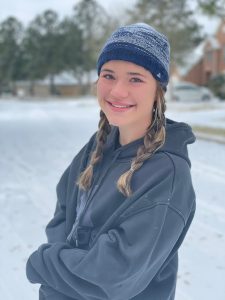
Name: Laura Davis
From: Katy, TX
Votes: 13
That was me, too.
That was me, too.
It is a hot, humid, sticky day— typical Texas weather that, to my friends’ horror, I have learned to embrace in my own strange way. It envelops me as I push myself out of the water. I mess with the knots of my chlorine-barraged hair and silently grieve the damaged split ends.
The driver readjusts her headband before checking the space behind her shoulders and scanning the rearview camera. She backs out slowly and hums along to the music as she leaves behind light-illuminated athletic fields.
My bare feet burn as I slip into my sun-cooked flip-flops. I throw the tanning oil into my swim bag and wipe my hands on my damp towel before throwing everything into the bin on the back of my mint green cruiser. I think nothing of the bike helmet that swings idly on my handlebars as I push open the heavy metal gate and wave goodbye to my friends.
The driver readjusts in her seat, and air conditioning blasts against the sweat that glistens on her skin and melts onto the grey, leather armrest. Mirrors, blinker, mirrors, blindspot, lane change; she is on the highway. Mirrors, blinker, mirrors, blindspot, lane change; she exits and makes a left turn. The passenger turns down the music, and the driver listens to him ramble on about his new favorite soccer team.
I settle into the seat of my bicycle and lean forward as my legs fight against the resistance of my slightly flat back tire, and when I near the busy street that I must cross to get into my neighborhood, my brakes squeal. Traffic. So much traffic. But the lights are red, and the approaching cars are driving slowly. A driver notices me and waves me forward, leaving room for me to cross and get to the safety of the median. I nod my head in appreciation and, albeit clumsily, urge my bike forward.
Mirrors, blinker, mirrors, shoulder, turn; the driver frowns at the unusual traffic building up at the all-too-familiar intersection. Her neighborhood entrance is only one turn away, and she tsks in minor frustration at the cars not turning right at the red light. Mirrors, blinker, mirrors, shoulder, turn; she enters the parking lot of the corner gas station. Mirrors, blinker, mirrors, shoulder, turn; one more lane change and she will be home.
It is a two-lane road on the busy side of the median, and as I pull past the friendly driver, it takes me a moment to register a second car. One that is advancing towards me, and not slowly. My reaction is delayed. The world around me turns numb; there is nothing I can do.
Mirrors, blinker, mirrors, shoulder, lane change; she takes a moment to register the ugly clash of metal on metal. The sinister screeching. She has been hit; she has hit something. Heart racing, mind turning, tears building, she pulls off the side of the road. What did she do?
To this day, the sound of screeching brakes haunts me, but I made it into the median safely. And the driver who did hit something? That was me, too. I pride myself on being a good driver, but I just hadn’t checked my shoulder well enough. Just. It was, from all angles, what one may consider a lucky collision. No lives were lost; damage was minimal. Just. What if I had just checked my shoulder better? What if the driver just hadn’t been paying enough attention as I was crossing the street? What if I had hit a biker instead of a car? What if. But so many more people— mothers and fathers, grandparents and cousins, friends and siblings— are not afforded the luxury of what-ifs. More than one million people die from vehicular accidents each year. Mothers and fathers, grandparents and cousins, friends and siblings— gone in the blink of an eye.
“What ifs,” do not bring closure. “Just enough,” is not enough. The guilt of causing an accident, of killing another person, remains with someone forever. No one expects it to happen to them. No one expects to be haunted by their decisions for the rest of their life. Until it happens.
It becomes imperative that drivers education concentrates not only on the technique of driving but also on the long-term consequences of overlooking cars for what they really are: weapons. Airplanes, buses, trains, boats— each of these modes of transportation is safer than cars. Driving gives people a false sense of control, but the reality is that even the best drivers cannot control others’ actions on the road. Even the best drivers can make mistakes— mistakes that ruin lives.
I cannot go back in time and put my bike helmet on. I cannot go back in time and pay better attention to the second lane of the busy street. I cannot go back in time and make the decision not to cut through the gas station. I cannot go back in time and check my shoulder better. But I can move forward and share my stories. And I can remind people that they may not be as lucky as I was. I could have been hit by that car. I could have killed someone— or been killed— for simply not seeing. These mistakes are not simple. They turn worlds upside down.